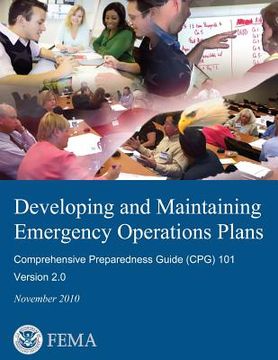Developing and Maintaining Emergency Operations Plans: Comprehensive Preparedness Guide (CPG) 101, Version 2.0 (en Inglés)
Reseña del libro "Developing and Maintaining Emergency Operations Plans: Comprehensive Preparedness Guide (CPG) 101, Version 2.0 (en Inglés)"
Comprehensive Preparedness Guide (CPG) 101 provides Federal Emergency Management Agency (FEMA) guidance on the fundamentals of planning and developing emergency operations plans (EOP). CPG 101 shows that EOPs are connected to planning efforts in the areas of prevention, protection, response, recovery, and mitigation. Version 2.0 of this Guide expands on these fundamentals and encourages emergency and homeland security managers to engage the whole community in addressing all risks that might impact their jurisdictions. While CPG 101 maintains its link to previous guidance, it also reflects the reality of the current operational planning environment. This Guide integrates key concepts from national preparedness policies and doctrines, as well as lessons learned from disasters, major incidents, national assessments, and grant programs. CPG 101 provides methods for planners to: Conduct community-based planning that engages the whole community by using a planning process that represents the actual population in the community and involves community leaders and the private sector in the planning process; Ensure plans are developed through an analysis of risk; Identify operational assumptions and resource demands; Prioritize plans and planning efforts to support their seamless transition from development to execution for any threat or hazard; Integrate and synchronize efforts across all levels of government. CPG 101 incorporates the following concepts from operational planning research and day-to-day experience: The process of planning is just as important as the resulting document; Plans are not scripts followed to the letter, but are flexible and adaptable to the actual situation; Effective plans convey the goals and objectives of the intended operation and the actions needed to achieve them. Successful operations occur when organizations know their roles, understand how they fit into the overall plan, and are able to execute the plan. Comprehensive Preparedness Guide (CPG) 101 provides guidelines on developing emergency operations plans (EOP). It promotes a common understanding of the fundamentals of risk-informed planning and decision making to help planners examine a hazard or threat and produce integrated, coordinated, and synchronized plans. The goal of CPG 101 is to make the planning process routine across all phases of emergency management and for all homeland security mission areas. This Guide helps planners at all levels of government in their efforts to develop and maintain viable all-hazards, all-threats EOPs. Accomplished properly, planning provides a methodical way to engage the whole community in thinking through the life cycle of a potential crisis, determining required capabilities, and establishing a framework for roles and responsibilities. It shapes how a community envisions and shares a desired outcome, selects effective ways to achieve it, and communicates expected results. Each jurisdiction's plans must reflect what that community will do to address its specific risks with the unique resources it has or can obtain. Planners achieve unity of purpose through coordination and integration of plans across all levels of government, nongovernmental organizations, the private sector, and individuals and families. This supports the fundamental principle that, in many situations, emergency management and homeland security operations start at the local level and expand to include Federal, state, territorial, tribal, regional, and private sector assets as the affected jurisdiction requires additional resources and capabilities. A shared planning community increases the likelihood of integration and synchronization, makes planning cycles more efficient and effective, and makes plan maintenance easier.

